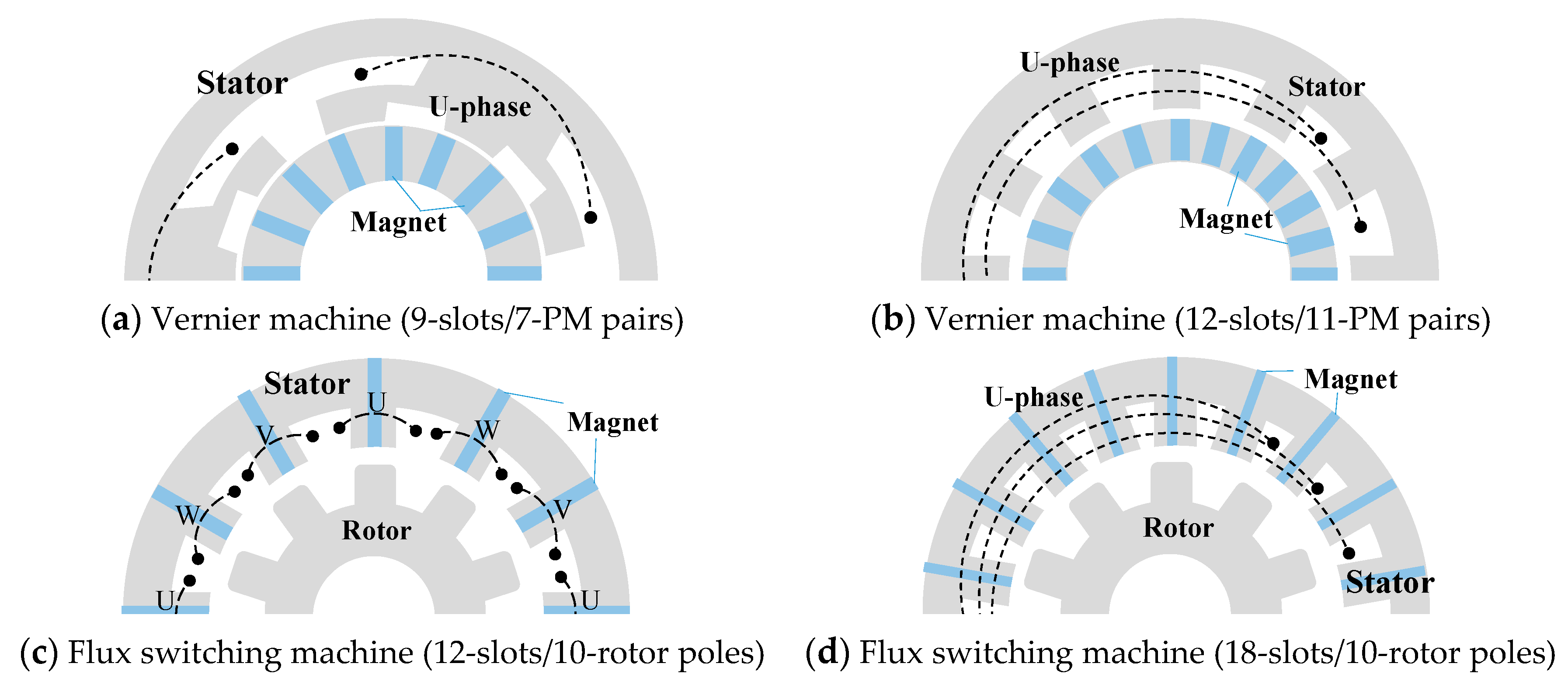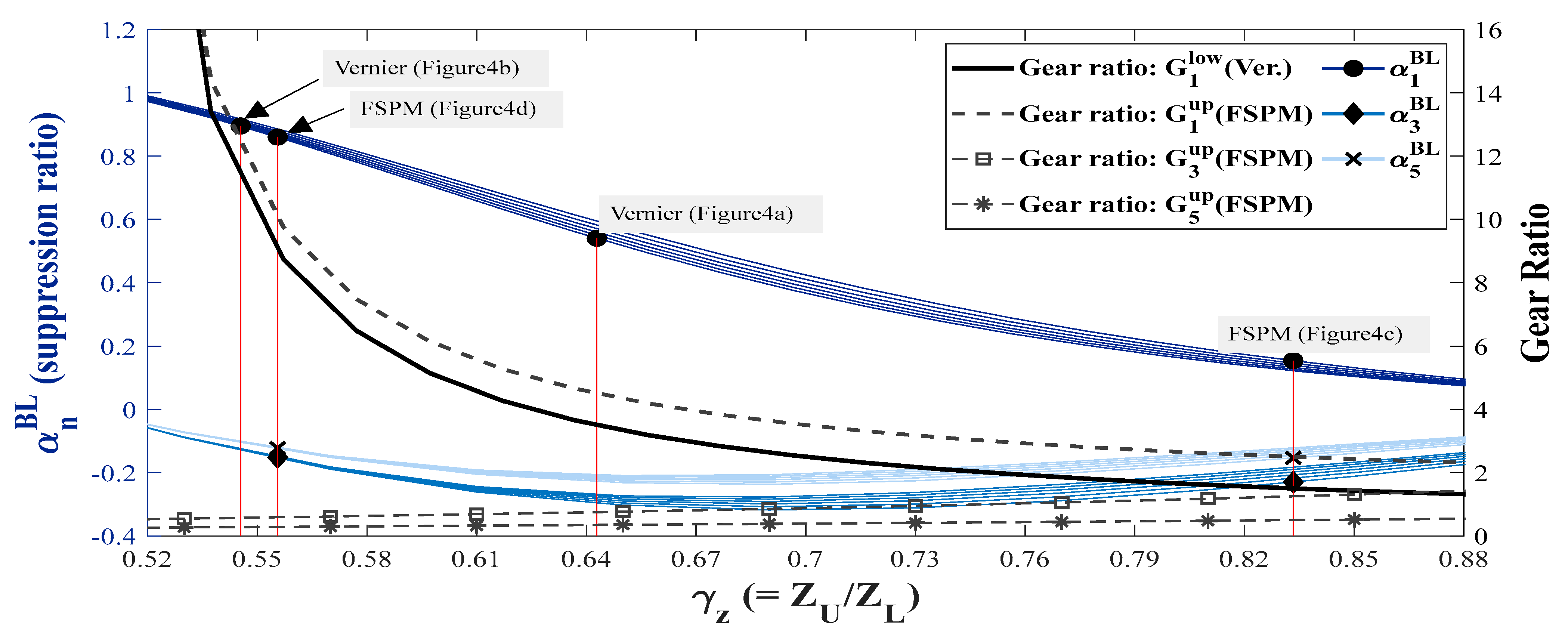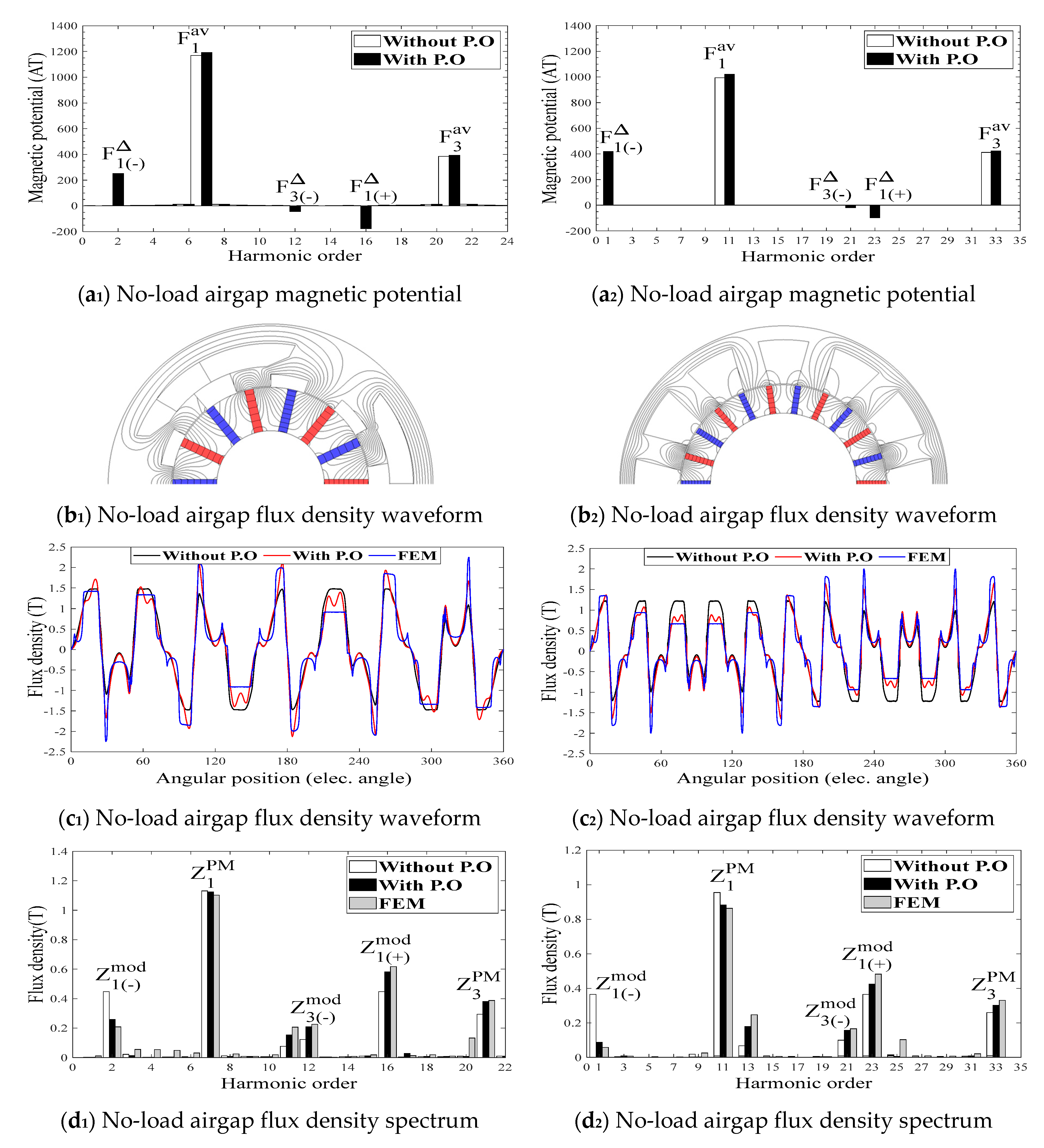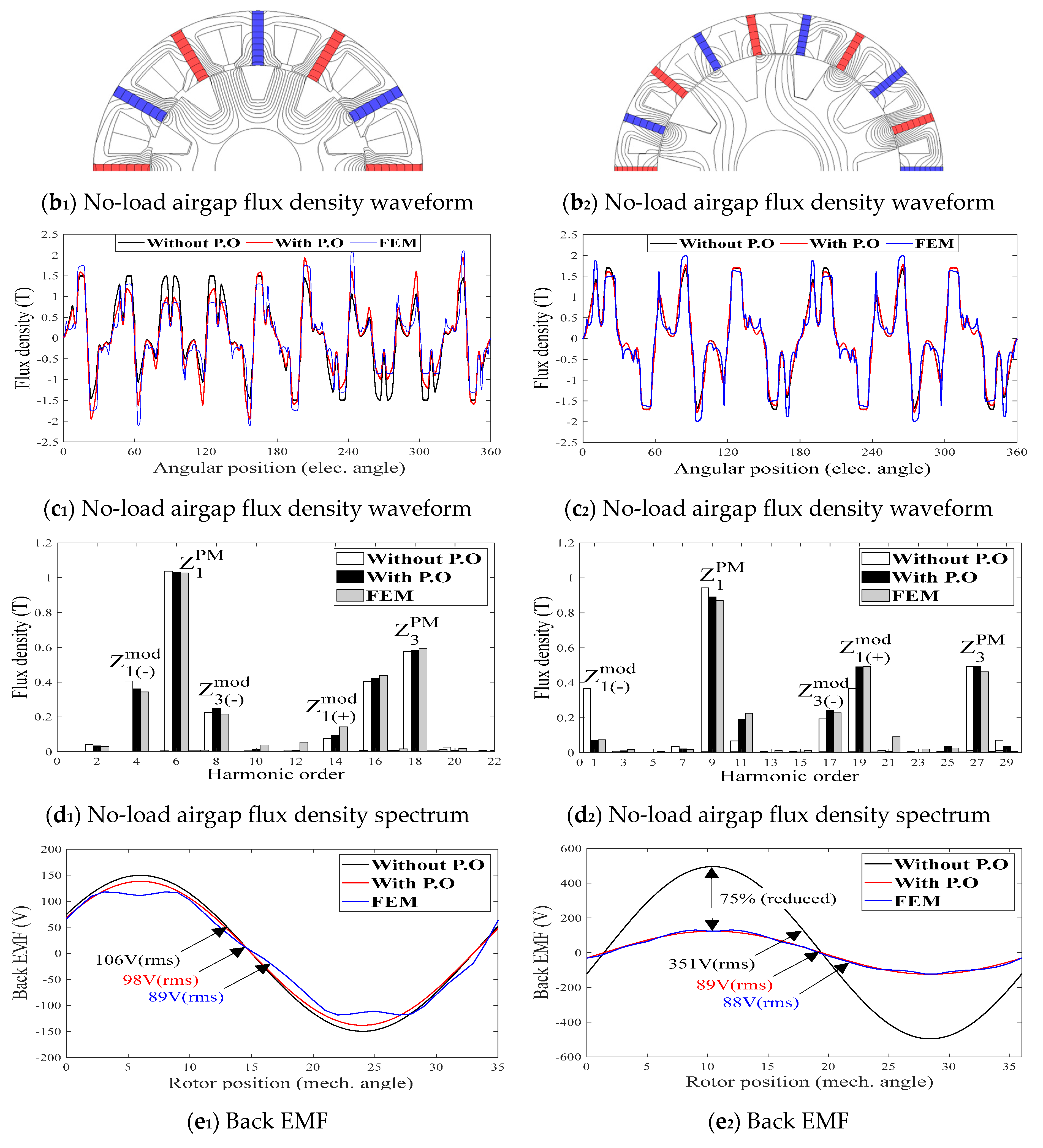Analytical Investigation of Magnetic Scalar Potentials Oscillation in Spoke PM Flux Modulation Machines
Abstract
:1. Introduction
2. Characteristic Equations Considering Magnetic Potential Oscillation
2.1. Generalized Equivalent Circuit Model of a Spoke-Array PM Machine
2.2. Analytical Expressions of Scalar Magnetic Potential
2.3. Air Gap Magneto-Motive Force
2.4. Air Gap Flux Density and Back EMF
2.5. Suppression Characteristics of Modulation Flux Due to Magnetic Potential’s Oscillation
3. Potentials Oscillation Behavior in Various Spoke PM Machines
3.1. Conventional Spoke PM Machine
3.2. Spoke PM Vernier Machine
3.3. Flux Switching PM Machine
4. Validation with Case Studies
4.1. Analysis Models
4.2. Procedure for Verification with FEM
4.2.1. Vernier Machine
4.2.2. Flux Switching Machine
5. Conclusions
Author Contributions
Funding
Data Availability Statement
Conflicts of Interest
Nomenclature
| Number of slots | |
| PMs/Number of iron core pieces | |
| PM Pole pairs | |
| Modulation pole pair | |
| Air gap length | |
| Radius of air gap | |
| Stack length | |
| PM magneto magneto-motive force | |
| Magnetic reluctance | |
| Leakage reluctance | |
| Scalar magnetic potential | |
| Average/fixed potential value | |
| Oscillating potential value | |
| Air gap flux | |
| Flux from PM | |
| Leakage flux | |
| Lumped permeance connected to kth core piece. | |
| Average value Lumped permeance | |
| Harmonic permeance | |
| Permeance function of upper side | |
| Permeance function of lower side | |
| Permeance′ coefficient | |
| Stationary axis | |
| Mover position in the air gap | |
| Angle in mover reference | |
| Winding factor | |
| Mechanical angular span of coil | |
| Gear ratio of vernier machine | |
| Gear ratio of FSPM machine | |
| Ratio of slots and PMs | |
| Suppression ratio | |
| FSC | Fractional slot oncentrate winding |
| IS | Integral slot winding |
| P. O | Potential oscillation |
Appendix A
Appendix B

References
- Vukotić, M.; Miljavec, D. Design of a Permanent-magnet Flux-modulated Machine with a High Torque Density and High Power Factor. IET Electr. Power Appl. 2016, 10, 36–44. [Google Scholar] [CrossRef]
- Liu, C. Emerging Electric Machines and Drives—An Overview. IEEE Trans. Energy Convers. 2018, 33, 2270–2280. [Google Scholar] [CrossRef]
- Ur Rahman, L.; Khan, F.; Khan, M.A.; Ahmad, N.; Khan, H.A.; Shahzad, M.; Ali, S.; Ali, H. Modular Rotor Single Phase Field Excited Flux Switching Machine with Non-Overlapped Windings. Energies 2019, 12, 1576. [Google Scholar] [CrossRef]
- Niu, S.; Ho, S.L.; Fu, W.N.; Wang, L.L. Quantitative Comparison of Novel Vernier Permanent Magnet Machines. IEEE Trans. Magn. 2010, 46, 2032–2035. [Google Scholar] [CrossRef]
- Li, J.; Chau, K.T.; Jiang, J.Z.; Liu, C.; Li, W. A New Efficient Permanent-Magnet Vernier Machine for Wind Power Generation. IEEE Trans. Magn. 2010, 46, 1475–1478. [Google Scholar] [CrossRef]
- Zhu, X.; Lee, C.H.T.; Chan, C.C.; Xu, L.; Zhao, W. Overview of Flux-Modulation Machines Based on Flux-Modulation Principle: Topology, Theory, and Development Prospects. IEEE Trans. Transp. Electrif. 2020, 6, 612–624. [Google Scholar] [CrossRef]
- Kim, B. Design Method of a Direct-Drive Permanent Magnet Vernier Generator for a Wind Turbine System. IEEE Trans. Ind. Appl. 2019, 55, 4665–4675. [Google Scholar] [CrossRef]
- Rehman, A.; Kim, B. Characteristics Analysis of Consequent-Pole Ferrite Magnet Vernier Machine Using Novel Equivalent Magnetic Circuit. IEEE J. Emerg. Sel. Top. Power Electron. 2022, 10, 1823–1833. [Google Scholar] [CrossRef]
- Chen, Q.; Liu, G.; Zhao, W.; Shao, M. Nonlinear Adaptive Lumped Parameter Magnetic Circuit Analysis for Spoke-Type Fault-Tolerant Permanent-Magnet Motors. IEEE Trans. Magn. 2013, 49, 5150–5157. [Google Scholar] [CrossRef]
- Carraro, E.; Bianchi, N.; Zhang, S.; Koch, M. Design and Performance Comparison of Fractional Slot Concentrated Winding Spoke Type Synchronous Motors with Different Slot-Pole Combinations. IEEE Trans. Ind. Appl. 2018, 54, 2276–2284. [Google Scholar] [CrossRef]
- Azeem, M.; Kim, B. Electromagnetic Analysis and Performance Investigation of a Flux-Switching Permanent Magnet Machine. Energies 2019, 12, 3362. [Google Scholar] [CrossRef]
- Li, D.; Qu, R.; Li, J.; Xu, W.; Wu, L. Synthesis of Flux Switching Permanent Magnet Machines. IEEE Trans. Energy Convers. 2016, 31, 106–117. [Google Scholar] [CrossRef]
- Kim, B.; Lipo, T.A. Operation and Design Principles of a PM Vernier Motor. IEEE Trans. Ind. Appl. 2014, 50, 3656–3663. [Google Scholar] [CrossRef]
- Kim, B.; Lipo, T.A. Analysis of a PM Vernier Motor with Spoke Structure. IEEE Trans. Ind. Appl. 2016, 52, 217–225. [Google Scholar] [CrossRef]
- Zou, T.; Li, D.; Qu, R.; Jiang, D. Performance Comparison of Surface and Spoke-Type Flux-Modulation Machines with Different Pole Ratios. IEEE Trans. Magn. 2017, 53, 1–5. [Google Scholar] [CrossRef]
- Ren, X.; Li, D.; Qu, R.; Yu, Z.; Gao, Y. Investigation of Spoke Array Permanent Magnet Vernier Machine with Alternate Flux Bridges. IEEE Trans. Energy Convers. 2018, 33, 2112–2121. [Google Scholar] [CrossRef]
- Zhu, Z.Q.; Howe, D. Instantaneous Magnetic Field Distribution in Brushless Permanent Magnet DC Motors. III. Effect of Stator Slotting. IEEE Trans. Magn. 1993, 29, 143–151. [Google Scholar] [CrossRef]
- Kim, B. Investigation on Slot–Pole Combinations of a PM Vernier Motor with Fractional-Slot Concentrated Winding Configurations. Energies 2017, 10, 1310. [Google Scholar] [CrossRef]
- Tlali, P.M.; Wang, R.-J.; Gerber, S.; Botha, C.D.; Kamper, M.J. Design and Performance Comparison of Vernier and Conventional PM Synchronous Wind Generators. IEEE Trans. Ind. Appl. 2020, 56, 2570–2579. [Google Scholar] [CrossRef]
- Chen, J.T.; Zhu, Z.Q. Winding Configurations and Optimal Stator and Rotor Pole Combination of Flux-Switching PM Brushless AC Machines. IEEE Trans. Energy Convers. 2010, 25, 293–302. [Google Scholar] [CrossRef]









| Parameters | Vernier Spoke PM Machine (Figure 4a,b) | Flux Switching Spoke PM Machine (Figure 4c,d) | ||
|---|---|---|---|---|
| Gear ratio | ||||
| Winding type | FSC | IS | FSC | IS |
| Air-gap radius | 100 mm | |||
| Stack length | 50 mm | |||
| Air-gap length | 1 mm | |||
| Magnet height | 44.8 mm | 28.5 mm | 52.5 mm | 35 mm |
| Magnet width | 8.9 mm | 5.7 mm | 10.5 mm | 6.9 mm |
| No. of slots, ZU | 9 | 12 | 10 | 10 |
| PM poles, ZL | 14 | 22 | 12 | 18 |
| Rotational speed | 600 rpm | |||
| Turns per Phase | 200 | |||
| γz (=ZU/ZL) | 0.64 | 0.54 | 0.833 | 0.56 |
| Suppression ratio (%) | = 58% | = 89% | = 15%, −23%, −15% | = 84%, −15%, −13% |
Disclaimer/Publisher’s Note: The statements, opinions and data contained in all publications are solely those of the individual author(s) and contributor(s) and not of MDPI and/or the editor(s). MDPI and/or the editor(s) disclaim responsibility for any injury to people or property resulting from any ideas, methods, instructions or products referred to in the content. |
© 2023 by the authors. Licensee MDPI, Basel, Switzerland. This article is an open access article distributed under the terms and conditions of the Creative Commons Attribution (CC BY) license (https://creativecommons.org/licenses/by/4.0/).
Share and Cite
Ur Rahman, L.; Rehman, A.; Kim, B. Analytical Investigation of Magnetic Scalar Potentials Oscillation in Spoke PM Flux Modulation Machines. Energies 2023, 16, 3658. https://doi.org/10.3390/en16093658
Ur Rahman L, Rehman A, Kim B. Analytical Investigation of Magnetic Scalar Potentials Oscillation in Spoke PM Flux Modulation Machines. Energies. 2023; 16(9):3658. https://doi.org/10.3390/en16093658
Chicago/Turabian StyleUr Rahman, Lutf, Abdur Rehman, and Byungtaek Kim. 2023. "Analytical Investigation of Magnetic Scalar Potentials Oscillation in Spoke PM Flux Modulation Machines" Energies 16, no. 9: 3658. https://doi.org/10.3390/en16093658








